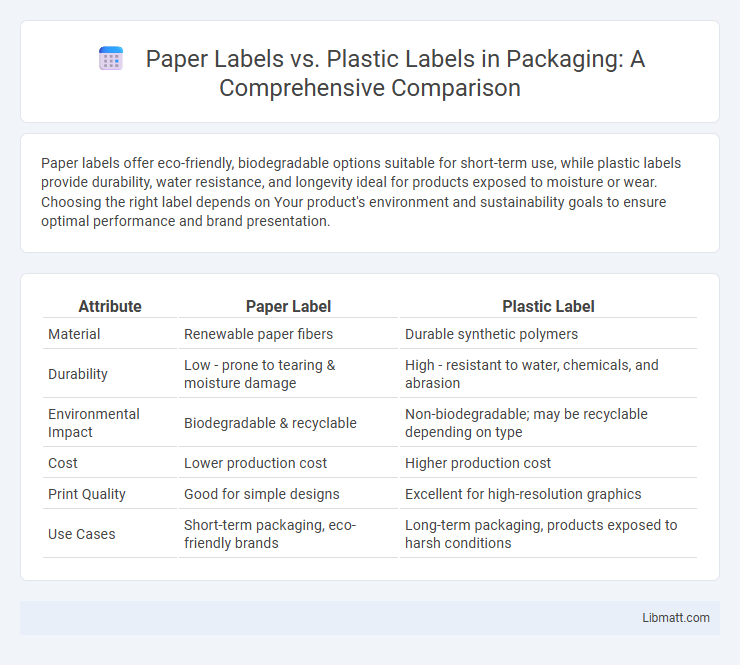Paper labels offer eco-friendly, biodegradable options suitable for short-term use, while plastic labels provide durability, water resistance, and longevity ideal for products exposed to moisture or wear. Choosing the right label depends on Your product's environment and sustainability goals to ensure optimal performance and brand presentation.
Table of Comparison
| Attribute | Paper Label | Plastic Label |
|---|---|---|
| Material | Renewable paper fibers | Durable synthetic polymers |
| Durability | Low - prone to tearing & moisture damage | High - resistant to water, chemicals, and abrasion |
| Environmental Impact | Biodegradable & recyclable | Non-biodegradable; may be recyclable depending on type |
| Cost | Lower production cost | Higher production cost |
| Print Quality | Good for simple designs | Excellent for high-resolution graphics |
| Use Cases | Short-term packaging, eco-friendly brands | Long-term packaging, products exposed to harsh conditions |
Introduction to Label Materials
Paper labels provide a natural, eco-friendly option with excellent printability and ease of recycling, making them ideal for short-term applications and products with minimal moisture exposure. Plastic labels, such as polypropylene or polyester, offer superior durability, water resistance, and chemical resistance, suited for long-term use in harsh environments. Choosing between paper and plastic labels depends on the specific product requirements, including exposure conditions, budget constraints, and environmental considerations.
Overview of Paper Labels
Paper labels offer a cost-effective, eco-friendly solution widely used across packaging, shipping, and retail industries due to their recyclability and biodegradability. They provide excellent print quality for detailed graphics and text, making them ideal for branding and product information on consumer goods. Paper labels are compatible with various adhesives and finishes, ensuring versatility for different surfaces and environmental conditions.
Overview of Plastic Labels
Plastic labels offer superior durability and resistance to moisture, chemicals, and abrasion compared to paper labels, making them ideal for products exposed to harsh environments. Materials such as polypropylene, polyethylene, and vinyl provide flexibility, tear resistance, and vibrant print quality for long-lasting branding. These labels are commonly used in industries like cosmetics, food and beverage, and pharmaceuticals where label longevity and appearance are essential.
Environmental Impact: Paper vs Plastic Labels
Paper labels have a lower environmental impact due to their biodegradability and recyclability, breaking down more easily in natural settings compared to plastic labels. Plastic labels, often derived from petroleum, contribute to long-lasting pollution and are harder to recycle, increasing landfill waste and environmental toxins. Choosing paper labels supports your eco-friendly initiatives by reducing plastic waste and promoting sustainable packaging solutions.
Cost Comparison of Paper and Plastic Labels
Paper labels generally cost less than plastic labels due to lower raw material and manufacturing expenses, making them an economical choice for short-term or disposable applications. Plastic labels, while more expensive upfront, offer durability and resistance to moisture, chemicals, and abrasion, leading to potential long-term savings by reducing replacements. Evaluating your product's storage conditions and lifespan can help determine whether the initial investment in plastic labels delivers better overall value compared to paper options.
Durability and Performance Factors
Paper labels offer eco-friendly options but tend to lack durability and water resistance compared to plastic labels, which excel in harsh environments due to their waterproof and tear-resistant properties. Plastic labels maintain vibrant colors and adhesion longer under exposure to moisture, chemicals, and UV light, making them ideal for outdoor or industrial use. Selecting the right label depends on your product's conditions and longevity requirements, where plastic labels provide superior performance for extended durability.
Design and Print Quality Considerations
Paper labels offer high-quality printing with vibrant colors and sharp details, making them ideal for intricate designs and branding purposes. Plastic labels provide superior durability and resistance to moisture, chemicals, and UV exposure, maintaining print quality over time in harsh environments. Choosing between paper and plastic labels depends on the balance between print aesthetics and long-term label performance.
Recycling and Sustainability Aspects
Paper labels offer superior recyclability due to their biodegradability and compatibility with most recycling processes, making them a more sustainable choice compared to plastic labels. Plastic labels often require specialized recycling methods and can contribute to microplastic pollution, presenting challenges for eco-friendly disposal. Choosing paper labels supports your brand's sustainability goals by reducing environmental impact and promoting a circular economy.
Industry Applications and Suitability
Paper labels are widely used in industries like food packaging, retail, and pharmaceuticals due to their cost-effectiveness, print quality, and biodegradability, making them suitable for short-term applications and eco-friendly products. Plastic labels, commonly applied in chemical, automotive, and personal care sectors, offer superior durability, resistance to moisture, chemicals, and UV exposure, ensuring long-lasting performance in harsh environments. The choice between paper and plastic labels depends on specific industry requirements for durability, environmental impact, and budget constraints.
Choosing the Right Label for Your Needs
Paper labels offer eco-friendly, cost-effective solutions ideal for short-term use and environments with low moisture, making them a popular choice for shipping and product packaging. Plastic labels provide superior durability, water resistance, and chemical resistance, suitable for outdoor applications or products exposed to harsh conditions. Assess your product's usage, environment, and budget to determine whether paper labels or plastic labels best meet your specific labeling needs.
Paper label vs plastic label Infographic

 libmatt.com
libmatt.com